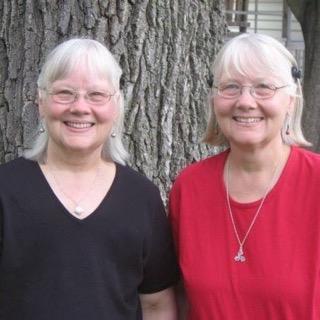When I first heard
Ye Toop Doram I realized what a great game song it is. I always thought it was traditional until a conversation with my friend, Marilyn Shepard, a 49 year veteran (!!!) of teaching children music who lives in California. Marilyn is an amazing teacher, musician, and collector of songs from around the world she has learned from students in her classroom! Oh- and one she learned while sitting on an airplane next to a woman from Ireland! She has a true collector's heart!
Following is an interview with Marilyn about
Ye Toop Doram.
Marilyn (red shirt) and her twin sister, Nancy (black shirt).
Aimee (me): How did you get interested in music from cultures not your own?
Marilyn: My twin sister, Nancy Paxson and I have had a passion for collecting folk songs, singing games, and instruments from around the world since we were very young - as well as composing songs for children.
My training was Orff and Kodaly and ethnomusical multicultural classes as well as vocal/choral. Traveling with choirs to Russia, Sweden, Finland, Estonia, Latvia, China, Costa Rica, Spain, and Portugal have added to my collections.
I am a Past President of our San Diego Orff Chapter and was a presenter at the National AOSA Conferences in 1991 and 2015. The sessions were titled "Indonesian Folklore for the Classroom", and "Children Sing and Play Music in Worship".
Now I am retired from the classroom, but work at the "Museum of Making Music" in Carlsbad, CA (an extension of NAMM) as a docent for student tours and still direct my Children's Choir at church. Many anthems are sung in non-English languages and use instruments from my collections; Hawaiian, Native American, Chinese, Indonesian, Kenyan, etc. My choir kids all play dulcimers, ukuleles, and recorders as well.
A: How did the song
Ye Toop Doram come about? Were you inspired by students or a family at your school?
M: Yes! Inspired by two students- one from Iran and one from Afghanistan. Both families with Persian language background.
I looked for very easy, repetitive music so that my primary age students would make connections with these girls (from Iran and Afghanistan).
I had seen a song, "My Ball" (Yeh Toop Dooram) in a book by Mary Lee Walker,
A World of Children's Songs, Friendship Press, 1983. I had made recordings of my Iranian student singing her very long and ornate version of the song and we agreed that it was not "accessible" to teach to other kids in her classroom, so we composed a whole new song.
My twin sister, Nancy, who also is a music teacher in Minnesota where we were raised, suggested the "hot ball" game for the rolling part of the song. Our melody started out super basic and then invited variations with more ornamentation. The song text evolved over the next years as I taught with an Iranian teacher at an International Baccalaureate School. We added instrumental experiences and varied language and rules.
A: How did the song spread?
M: I first presented it in 1999 at the Inland Counties AOSA workshop. As you know, music teachers like to share "fun finds" so it was passed along in Orff and Kodaly circles. A teacher friend from Iran wrote out the Arabic version we ended up using.
We changed the B Section text to "ghelesh bede" ... roll the ball away, and drums other instruments accompanied changing from a steady beat during the passing part, to the rhythm of the text on the rolling part.
A: How did you play it?
M: We always did it in a seated circle. Using a small 6" playground ball. The person in the middle closed their eyes as we passed it. They would not know if we were passing clockwise or CCW. Then open their eyes on the third count and quickly assess their jumping/dodging needs. If they were not tagged or caught by the rolling ball after 8-10 rolls they became a "champ" and chose another jumper.
A: What is the translation?
M: Toop = Ball, Doram = mine, so "The ball is mine" or "It's my ball".
Yek Doh Seh = One, two, three.
Lol-beday - = roll it away, Toopeh to cha - small ball.
Ghelesh behday = roll away.
Many thanks to Marilyn for sharing her information, pictures, and songs with us! Hope you have enjoyed learning more about Ye Toop Doram and if you haven't tried it, give it a go with your students- it is a perpetual favorite in my classroom!




















































